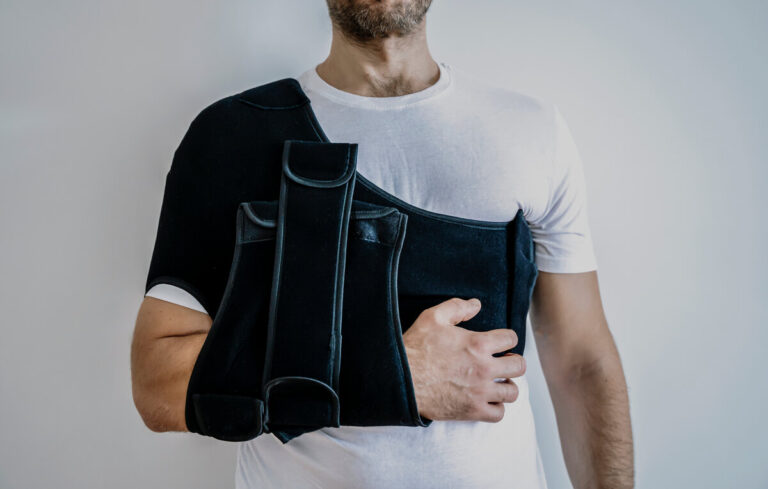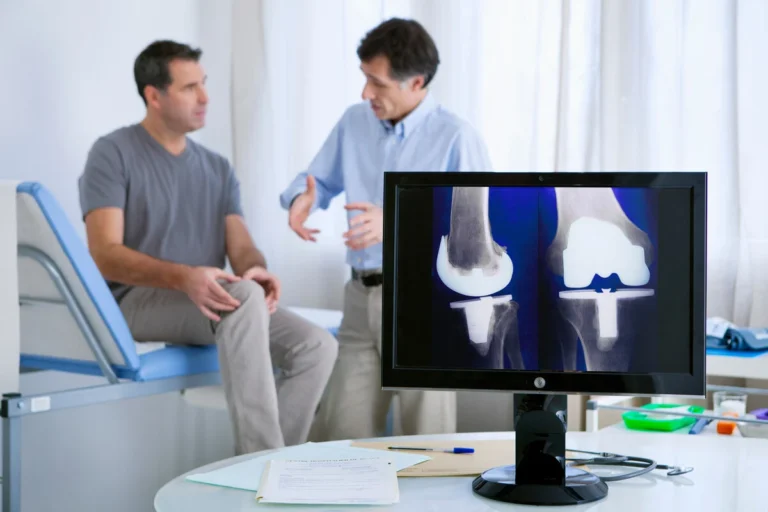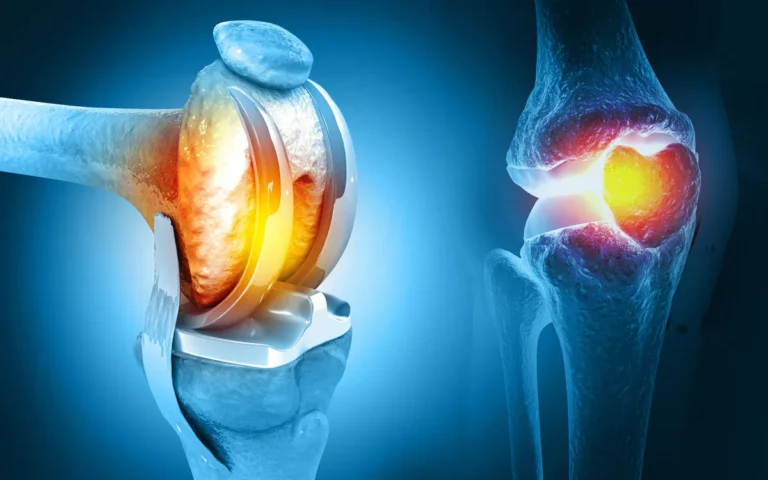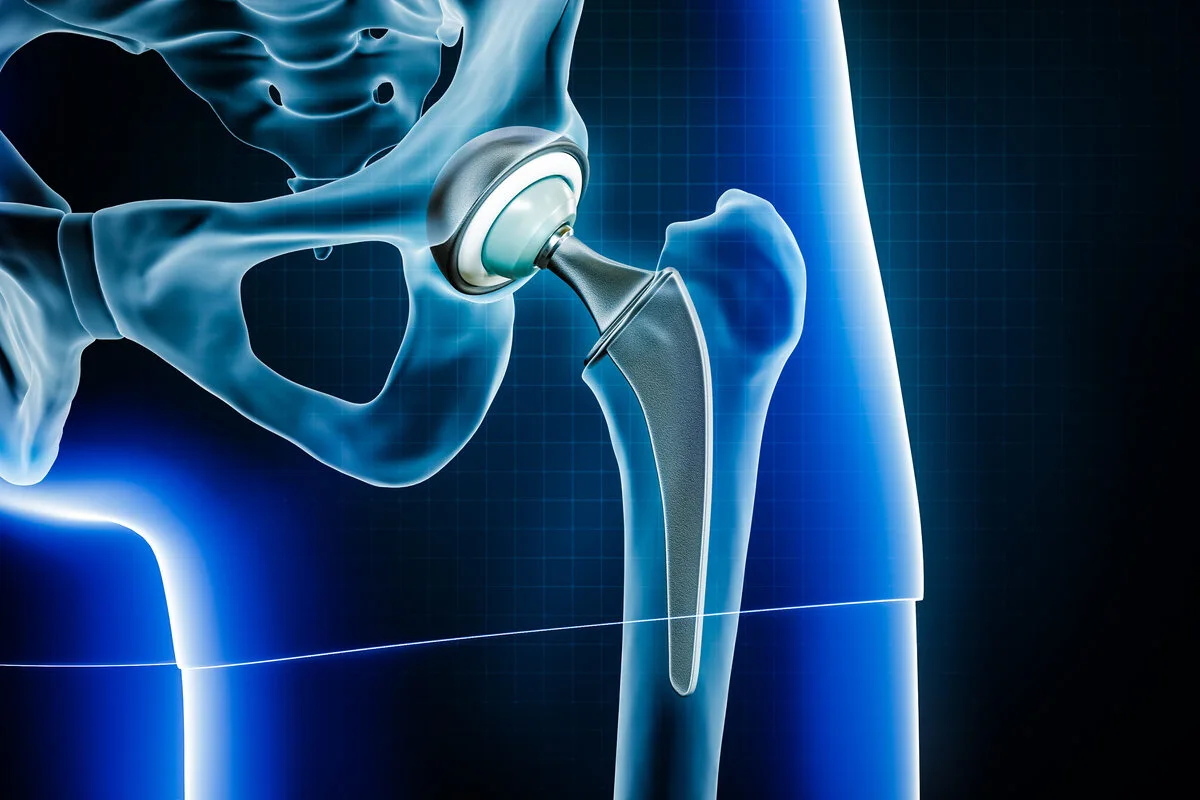
Introduction To Hip Replacement Recovery
Embarking on the journey of hip replacement recovery can feel both hopeful and overwhelming for many active adults. Understanding the process is the first empowering step toward reclaiming your mobility and quality of life. Hip surgery, specifically total hip replacement, is a well-established solution for those experiencing chronic pain or limited motion from arthritis, injury, or wear and tear. This type of procedure is one piece of the broader category known as total joint replacement, where damaged joints are replaced with functional implants to help restore movement and relieve pain. Its purpose is clear: replace the damaged joint with a new, functional implant, helping you return to the activities and independence you cherish.
The period immediately after surgery is crucial. While the procedure itself addresses the source of physical discomfort, the true key to a successful outcome lies in a thoughtful recovery and rehabilitation plan. At Bull City PT, we believe that your recovery journey is unique, shaped by factors such as age, pre-surgery activity level, overall health, and the specifics of your surgery. That means your path may look different from someone else’s.
Hip Replacement Recovery and Rehabilitation: Why They Matter
Rehabilitation is the bridge from surgery to full function. Through targeted physical therapy, you’ll gradually regain strength, movement, and confidence. Each phase of recovery comes with specific goals, such as managing pain—rehabilitation is designed to alleviate pain and improve comfort—reducing swelling, improving flexibility, and finally restoring safe independence in walking and daily activities. Skipping or underestimating this process can hinder your progress, compromise your new joint’s longevity, and limit the improvement in your quality of life.
The recovery process is a multi-stage journey that unfolds over several months, and supporting each stage is crucial for optimal outcomes.
What To Expect Right After Surgery
Immediately following hip surgery, you may experience some pain, swelling, and stiffness—these are normal early signs that your body is healing. After surgery, patients are moved to the recovery room for close monitoring, where vital signs are carefully observed to ensure stability before further care begins. In the hospital, your care team will guide you through your first steps, teaching basic exercises and precautions to protect your new joint. The physical therapy team plays a key role in helping you start walking early and assisting with mobility using assistive devices. Most patients begin gentle movement within a day, under supervision, to jumpstart recovery and prevent complications. The Bull City PT team will work closely with you, ensuring you understand your individual plan and know what milestones to aim for each week.
Recovery is not a sprint—it’s a journey. With support, encouragement, and expert guidance from experienced physical therapists like those at Bull City PT, you can look forward to steady progress and meaningful improvements. Our mission is not just to help you heal but to see you thrive, every step of the way.
How Long Does It Take To Walk Normally After Hip Surgery?
After hip replacement surgery, most patients are eager to regain their mobility and start walking comfortably again. For many, walking normally starts to feel achievable between 4 to 8 weeks post-surgery, although this timeline can vary depending on individual health, commitment to physical therapy, and age. These are important factors that influence both the speed of recovery and the overall outcomes after surgery. Generally, the goal is for patients to begin using assistive devices like walkers or crutches immediately after surgery, gradually transitioning to walking unaided as healing progresses and strength improves. The rate of progress may look different for someone recovering in their 60s compared to individuals in their 70s or 80s, but a supportive, structured approach makes walking recovery a realistic and empowering goal for all.
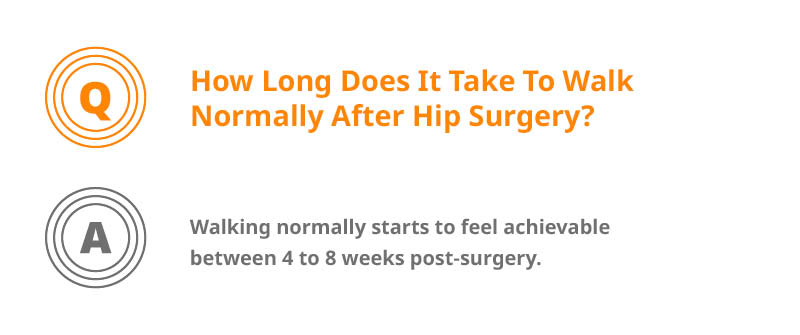
Expected Mobility Timeline Post-Surgery
In the initial days post-surgery, patients will start walking—with guidance from the medical team—using a walker. Most individuals are encouraged to stand and take a few steps, often on the same day as surgery or the following day. The first week is focused on short walks in your home, frequent standing, and gentle movement to encourage blood flow and prevent complications. By the end of week one, you should aim to walk several times a day, typically covering short distances like from bedroom to bathroom or around the house.
Many patients notice significant improvement in pain and mobility at about two weeks post-surgery, which is often when they begin to transition to walking longer distances or may start to reduce their reliance on a walker.
Week-By-Week Walking And Activity Milestones
During weeks two through four, walking distances gradually increase, and many people feel ready to start using a cane instead of a walker. Outpatient physical therapy introduces more targeted gait training and strengthening exercises. Attending an outpatient facility provides access to specialized equipment and professional support, which can enhance recovery outcomes compared to home-based sessions. By week four to six, some patients can begin walking short distances outside, such as to the mailbox or around the block, still prioritizing hip replacement recovery best practices. Steady progress continues, and by two to three months, the majority of patients return to walking normally for their daily tasks and errands, with improved confidence and comfort.
Recovery Time Variations By Age: 60, 70, And 80-Year-Olds
Your age can impact both the speed of recovery and the outlook for regaining a normal gait. For active adults in their 60s, the total hip replacement recovery week by week milestone may advance slightly faster, with unaided walking frequently achieved around 4-6 weeks post-op. Those in their 70s typically experience normal walking between 6-8 weeks, while patients in their 80s may need 8-12 weeks or more for comfortable, independent ambulation. However, other factors such as overall health, the extent of surgery, and adherence to rehabilitation also play a significant role in recovery time. Regardless of age, working closely with your physical therapist ensures the approach is tailored to your capability and needs.
How Far Should I Be Walking 1 Week After Hip Replacement?
During the first week after hip replacement, most patients should focus on frequent, short walks around their home—usually a few minutes, several times daily. While it may be tempting to push further, slow and steady is safest. Your physical therapist will guide you on the best distance based on your unique progress, and will also instruct you on how much weight you can safely place on your operated leg during these early walks. Short indoor walks and standing intervals are appropriate goals for this crucial early stage.
Physical Therapy’s Role And Realistic Expectations
Structured physical therapy is essential for successful hip replacement recovery. Therapists help you learn how to move safely, strengthen supporting muscles, and perfect your walking technique. They also support you emotionally, helping you set realistic milestones and adjust goals as your body adapts to new demands. Celebrate every step forward and trust that consistency leads to steady improvement.
Tips For Faster And Safer Ambulation
To accelerate your recovery and reduce risks, follow your therapist’s advice closely, maintain proper nutrition, and avoid overexertion. Use assistive devices as long as needed, listen to your body, and communicate any concerns to your care team. Staying active with appropriate movement helps you build strength and regain independence faster, while patience and positivity keep you moving forward each day. When approved by your therapist, stair climbing can also be a valuable exercise for restoring strength and endurance during hip replacement recovery.
What Are The Three Rules After Hip Replacement?
The three primary rules after a hip replacement—no bending your hip beyond 90 degrees, no crossing your legs, and no inward twisting of the operated leg—are foundational precautions that protect your new joint during the vulnerable weeks immediately following surgery. These precautions help prevent hip dislocation, one of the main complications during hip replacement recovery, especially in the early stages. Adhering to these rules not only speeds up healing but also sets the stage for long-term joint health and mobility.
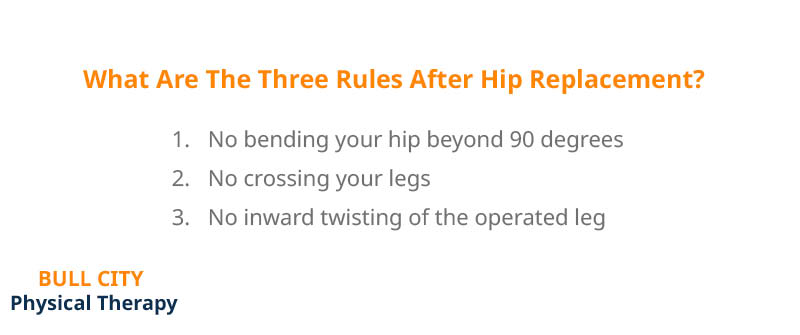
These precautions may be adjusted based on the different types of hip replacement procedures or surgical approaches used, such as total hip replacement, hip resurfacing, or the posterior and anterior methods.
Understanding The Three Rules
Let’s break down each rule and why it matters:
- No Bending Beyond 90 Degrees: This precaution means you should avoid motions that bring your thigh and torso too close. Everyday activities like tying shoes, picking up items from the floor, or sitting in low chairs can put your hip at risk. Using adaptive tools such as reachers and raised chairs helps maintain a safe range of movement.
- No Crossing Your Legs: This rule is especially important when sitting or lying down. Crossing legs can put undue stress on the hip joint and increase the risk of dislocation. Instead, keep your legs parallel and feet facing forward—consider using pillows to support positioning during rest.
- No Inward Twisting: Avoid rotating your operated leg inward, which can happen when turning to get up from a chair or pivoting quickly. Turning your whole body instead of twisting your hip is key to keeping your joint safe.
Why Are These Rules Crucial For Recovery?
After surgery, the soft tissues around your hip joint are healing, and the artificial joint needs time to fully integrate with your body. The three rules are designed to minimize movements that could force the joint out of place. Dislocation risk is highest in the first several weeks post-surgery, so rigorously following these guidelines gives you the best chance at a complication-free hip replacement recovery.
How Long Do I Need To Follow These Rules?
Most patients are instructed to follow these hip precautions for at least 6 to 12 weeks after surgery. However, depending on your surgeon’s preference and the type of hip replacement, these restrictions may extend or be slightly modified. Your surgeon and therapist will assess how you respond to surgery and rehabilitation before adjusting or lifting any restrictions. Always discuss timelines and program updates with your physical therapist and surgeon, especially if you experience discomfort or uncertainty about safe movement.
Common Mistakes And How To Avoid Them
It’s easy to accidentally break these rules, especially during routine daily tasks or if you become forgetful as your pain decreases. Some common mistakes include sitting on low sofas, abruptly turning while walking, or slipping your foot inward while putting on shoes. Setting up your home with assistive devices, reviewing safe movement techniques with your Bull City PT physical therapist, and enlisting family support can help you stay on track. Remember, each patient’s recovery is unique—at Bull City PT, our therapists coach you through proper body mechanics and gentle reminders, empowering you to regain confidence safely.
Following these three essential rules is a cornerstone of a successful hip replacement recovery. With expert guidance from Bull City PT, you’ll build new habits that protect your joints today and fuel your active lifestyle for years to come.
What Are The Permanent Restrictions After A Hip Replacement?
Permanent restrictions after hip replacement are typically in place to protect your new joint for the long term and prevent complications such as dislocation, excess wear, or injury. Long-term risks after hip replacement can also include complications involving the bone, such as failure of the implant to bond properly. Fracture around the implant or in the surrounding bone is another potential complication that may require further intervention. While modern surgical techniques allow for considerable mobility and independence post-surgery, it is essential to be aware of and respect certain limitations for the lifetime of your hip implant. Permanent restrictions after hip replacement are similar in some ways to those after knee replacement, but there are differences in post-surgical care and precautions, especially regarding joint positioning and the prevention of complications. Understanding these restrictions can empower you to enjoy an active lifestyle safely and confidently while reducing your risk of setbacks.
Which Movements Should Be Avoided After A Hip Replacement?
After a hip replacement, most surgeons recommend avoiding activities that place excessive stress on your new joint. This includes high-impact sports such as running, basketball, or singles tennis, as well as exercises that involve quick twisting, jumping, or abrupt direction changes. Movements involving deep hip bends, such as squatting or certain yoga poses, can increase your risk of joint dislocation. It’s generally advisable to avoid kneeling on the operated side and repetitive heavy lifting, both of which can put undue pressure on the implant.

What Exercises Should I Avoid Permanently?
Certain hip replacement exercises to avoid are those that force your leg across the midline (crossing legs), bend your hip beyond 90 degrees, or twist the hip inward. For lifelong safety, minimize activities like deep lunges, high kicks, full squats, or contact and collision sports. Always consult your therapist or surgeon before attempting a new activity, especially if you’re unsure of its safety.
How Can I Adjust My Lifestyle And Activities After Surgery?
Adjusting your lifestyle after a hip replacement does not mean giving up your favorite activities—it often requires modifying them. Embrace lower-impact activities like walking, swimming, biking, or golfing, which can help you stay active while protecting your joints. Incorporate exercises that specifically target the hips to improve hip mobility and stability during recovery. When returning to hobbies or work, consider ergonomics: use supportive chairs, avoid low seating, and use assistive devices if needed to avoid risky positions. With guidance, most active adults resume fulfilling, energetic lives while honoring these restrictions.
Is It Possible To Resume My Hobbies And Work Safely?
Absolutely! With a few adaptations, many people return to gardening, golfing, traveling, and even moderate hiking. Regular exercise is essential to restore strength and function in the hip after surgery, helping you regain mobility and reduce discomfort. Your physical therapist at Bull City PT can help tailor your rehabilitation plan and offer specific advice for your job or recreational interests. Being proactive, communicating with your care team, and listening to your body are all crucial in navigating life after a hip replacement and ensuring long-term joint health.
Does Walking Reduce Swelling After Hip Replacement?
Yes, walking after hip replacement can help reduce swelling, but it’s important to balance movement with rest to promote optimal swelling reduction and healing. Early and gentle ambulation improves circulation, which helps your body clear excess fluid from the surgical area. However, overdoing it or ignoring pain can actually worsen swelling, so it’s crucial to follow your physical therapist’s guidance and listen to your body as you recover.
What Is the Role Of Walking In Managing Post-Op Swelling?
After a hip replacement, your leg will likely swell due to surgery and decreased circulation from initial inactivity. Walking after hip replacement encourages blood flow and lymphatic drainage, both of which are key to swelling reduction. Short, frequent walks—starting with just a few minutes and gradually increasing daily—are effective. In fact, gentle activity helps prevent complications such as blood clots, making walking a cornerstone in your early recovery plan.
Guidelines For Safe Ambulation
To walk safely after your procedure, use any prescribed aids like walkers or canes, and make sure to walk on even surfaces. Avoid long walks or strenuous activity until your physical therapist advises you to progress. Most importantly, wear comfortable, supportive shoes and never push through significant pain or fatigue. At Bull City PT, our therapists will create a personalized plan so you know exactly how far and how often to walk based on your unique condition.
Other Effective Swelling Reduction Strategies
While walking is beneficial, it’s also crucial to incorporate other techniques for managing post-operative swelling. Elevate your leg periodically throughout the day to allow gravity to help move fluid away from the joint. Applying ice packs as directed can also soothe discomfort and minimize inflammation. Compression stockings, deep breathing exercises, and adequate hydration further contribute to optimal hip replacement recovery. Your Bull City PT team will demonstrate these methods to ensure you use them safely and effectively.
Warning Signs And When To Seek Medical Attention
Mild to moderate swelling is common as your body heals, but there are symptoms you shouldn’t ignore. Notify your surgeon or physical therapist if you experience sudden or dramatically increased swelling, redness, warmth, or pain that doesn’t improve with rest. These could indicate complications like blood clots or infection, which require prompt medical attention. Staying vigilant and maintaining open communication with your care team are important steps for a safe and successful recovery.
What Is The Hardest Part Of Hip Replacement Recovery, And Final Tips For Success
The hardest part of hip replacement recovery typically varies from person to person but often centers around coping with pain, stiffness, limited mobility, and the emotional ups and downs of the healing process. However, it’s important to note that the success rate of hip replacement recovery is high, with most patients experiencing significant improvements in pain and mobility. While regaining physical function is challenging, staying motivated and mentally resilient can be equally demanding, especially when progress slows or setbacks occur. By understanding these potential struggles and adopting proven strategies for success, you can face recovery with greater confidence and clarity.
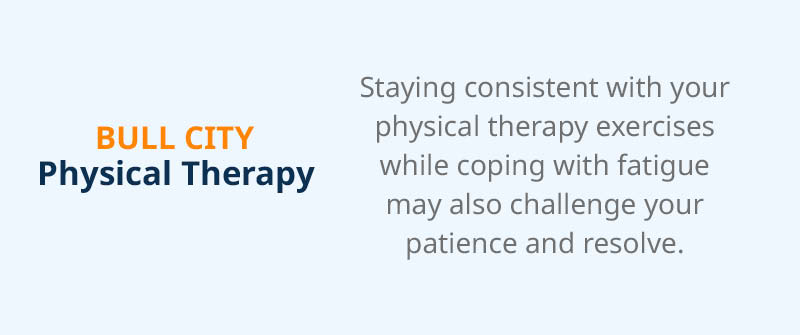
What Is The Hardest Part Of Hip Replacement Recovery?
Many people find that managing pain and stiffness in the early weeks can feel overwhelming, particularly as swelling and limitations restrict movement. Staying consistent with your physical therapy exercises while coping with fatigue may also challenge your patience and resolve. It’s important to acknowledge that feelings of frustration or discouragement are normal—healing is rarely a straight line, and there will be good days and tough days alike. The initial period of restricted mobility, dependence on assistive devices, and adjusting to new routines can test your emotional well-being and your commitment to rehabilitation.
How Can I Overcome Emotional And Physical Challenges In Hip Replacement Recovery?
Building a strong recovery foundation means addressing both physical and emotional needs during rehabilitation. Cultivating patience is key: remember that small steps forward make a big impact over time. Set realistic goals for yourself, celebrate each milestone, and recognize the progress you’re making—even on challenging days. Successful hip replacement recovery not only restores mobility but also contributes to improved overall health and quality of life.
Lean on your support network of loved ones, caregivers, and professionals. Don’t hesitate to talk to your physical therapist about any concerns; they can adjust your recovery plan as needed and provide encouragement tailored to your situation. Prioritize rest, nutritious food, hydration, and sleep, as these support your body’s healing processes. Implementing stress-reduction techniques such as deep breathing, mindfulness, or gentle meditation can also help you cope with setbacks or anxiety.
What Mindset Helps With Hip Replacement Rehabilitation?
Adopting a growth mindset—one that views challenges as opportunities for growth rather than barriers—can be transformative in your recovery journey. Approach setbacks as learning experiences and stay focused on what you can control: your attitude, effort, and willingness to adapt. Remember, every recovery path is unique; comparing yourself to others can breed unnecessary frustration. Embrace your journey and trust in your capacity to heal.
What Are The Best Final Tips For Hip Replacement Recovery?
Stay actively engaged with your physical therapy program, as consistency leads to the best outcomes. Regular communication with your care team ensures your plan fits your evolving needs and keeps you on track. It is important to follow your care team’s instructions regarding medication for pain and inflammation after surgery, as proper medication management supports your recovery. Pain medication plays a key role in managing discomfort during the initial recovery period, and you will gradually reduce its use as healing progresses. Be sure to stop taking narcotic pain medications before resuming activities like driving, as part of safe recovery practices. Keep moving within your doctor or therapist’s recommendations, avoid risky activities as advised, and gradually reintroduce hobbies and exercise routines when cleared. Remember, full recovery after hip replacement can take several weeks to months, and ongoing exercises and physical therapy are essential for regaining complete hip function. Don’t neglect ongoing joint health—strengthening supportive muscles and maintaining a healthy lifestyle will protect your new hip for years to come.
If you’re seeking a recovery partner who offers expert guidance, compassionate encouragement, and truly personalized care, Bull City PT is here for you. Our team empowers active adults like you to overcome the toughest parts of recovery, stay motivated, and achieve lasting mobility and well-being. Let us help you return to the activities you love with confidence—reach out today, and step boldly into your next chapter of strength and independence!



